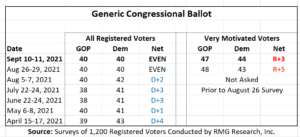Following President Biden’s speech and new COVID mandates, the Generic Congressional Ballot remains essentially unchanged. The latest Scott Rasmussen poll shows that, if the election were held today, 40% of Registered Voters would vote for the Democrat from their Congressional District while 40% would vote for the Republican.
Those numbers are unchanged since late August. In five surveys conducted earlier in the year, Democrats led by one-to-four percentage points.
Six percent (6%) say they will vote for some other candidate while 14% are not sure.
Enthusiasm for voting increased across the board following the president’s speech.
Among those who are Very Motivated to vote, the Republicans lead by a 47% to 44% margin. That’s little changed from a month ago. The GOP advantage stems largely from the fact that voters who prefer policies of President Trump are more motivated to vote than others.
Among all Registered voters, Republicans have a modest 30% to 25% advantage.
Democrats have a huge lead among urban voters matched by a huge Republican lead among rural voters. Suburban voters are evenly divided.
Republicans lead among voters who are at least 55. Democrats lead among younger voters.
SIGN UP to receive Scott’s free email newsletter.
CHECK OUT Scott’s latest polls.
Note: Neither Scott Rasmussen, ScottRasmussen.com, nor RMG Research, Inc. have any affiliation with Rasmussen Reports. While Scott Rasmussen founded that firm, he left more than seven years ago and has had no involvement since that time.
Methodology
The survey of 1,200 Registered Voters was conducted by Scott Rasmussen using a mixed mode approach from September 10-11, 2021. Field work for the survey was conducted by RMG Research, Inc. Most respondents were contacted online or via text while 239 were contacted using automated phone polling techniques. Online respondents were selected from a list of Registered Voters and through a process of Random Digital Engagement. Certain quotas were applied, and the sample was lightly weighted by geography, gender, age, race, education, internet usage, and political party to reasonably reflect the nation’s population of Registered Voters. Other variables were reviewed to ensure that the final sample is representative of that population.
The margin of sampling error for the full sample is +/- 2.8 percentage points.



